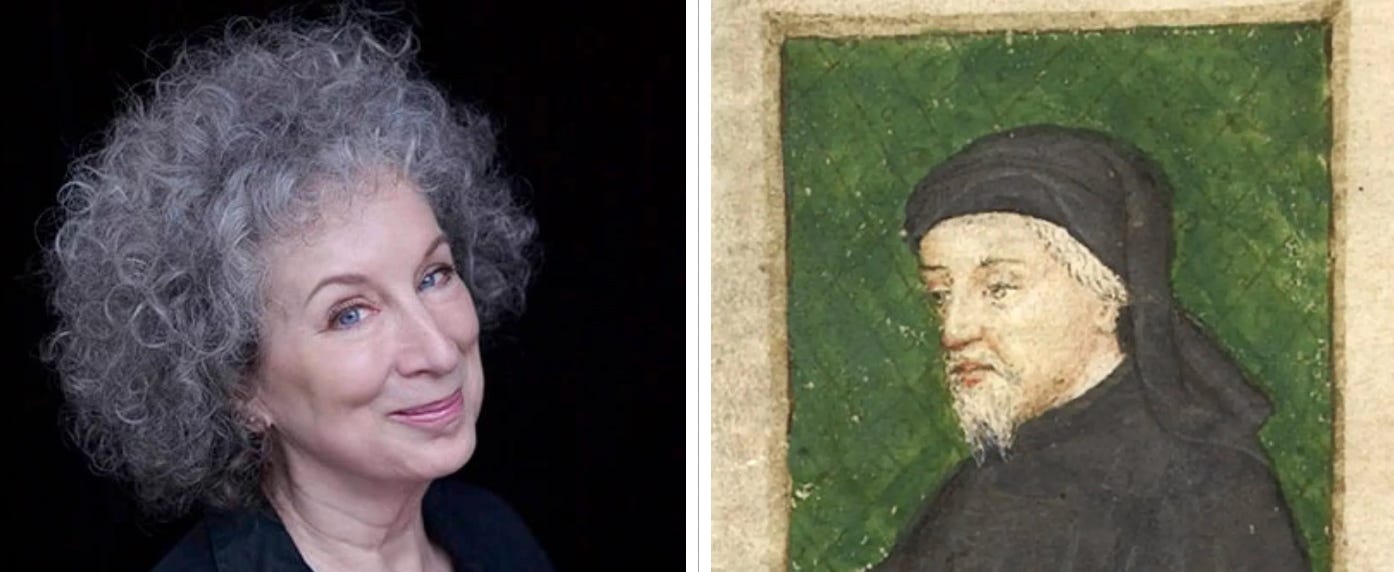The Massachusetts Medievalist on Atwood’s Latest (no spoilers)
The Massachusetts Medievalist has emerged from brumation because of her excitement about Margaret Atwood’s latest project, the “collaborative novel” Fourteen Days, which appeared this past February.
The copy of Fourteen Days I checked out of the library has a “short stories” sticker on its spine, and I imagine it must have been an entertaining puzzle to try to figure out how to describe and shelve this book. It’s a novel; it’s a collection of stories; it’s a framed narrative that blends the two .
The HarperCollins site lists “The Authors Guild” as first author, followed by Atwood and Douglas Preston as authors, while the book’s cover refers to Atwood and Preston as editors. Thirty-six writers contributed sections of the text, providing the narratives and voices of residents in a New York apartment building in the first days of COVID lockdown, who gather nightly on their rooftop to cheer essential workers, drink prodigious amounts of alcohol, and tell each other stories.
One of the joys of 14D is its generic challenge - it is simultaneously both a novel and an edited collection of short stories. I wouldn’t recommend dipping into 14D at random, as a reader might with a more standard short story collection. It needs to be read in sequence.
I’ve been intrigued with Atwood’s relationship with medieval literature in her other books, most notably The Testaments, and the medieval vibe pulses as well through 14D. Most obviously, the collection alludes to Boccaccio’s fourteenth-century Decameron, a collection of stories told by different narrators as they escape the plague in a villa outside Florence (“Decameron” roughly translates to “10-days”).
But there are also echoes of Chaucer’s Canterbury Tales, most evidently in the variety of narrative voices. While Boccaccio ostensibly has ten different narrators, the narrative voice of the Decameron is largely static throughout the text, with the narrators in the frame sections somewhat conventional and undeveloped. Chaucer (who knew Decameron) presents the various voices of his Canterbury pilgrims to be very distinct - the Wife of Bath doesn’t “sound” like the Man of Law or the Nun’s Priest.
Atwood and Preston have gone (at least) one step further than Chaucer, using actually different authors to provide the stories told by the different tenants on the different days (31 March - 13 April 2020). 14D is deliberately “unbylined” (vii), although the contributors are listed in alphabetical order in the front matter and their specific contributions are identified in the back matter. The book thus sets up an optional contemporary-literature matching game, as some readers will enjoy trying to guess which authors contributed which sections (note that some days have more than one contributor and some contributors wrote sections of more than one day, so the matching game can become a bit complicated!)
One way that 14D is a novel, not a short story collection, is its unity around a main character (not found in Canterbury Tales or Decameron), and the character of the apartment’s superintendent is not just our guide to the building and its tenants but also a developed, complicated, and sympathetic character with some good stories and an intriguing past.
No spoilers today, although there will be some in the next post - please pick up 14D and post a comment about how many authors you were able to identify!!





